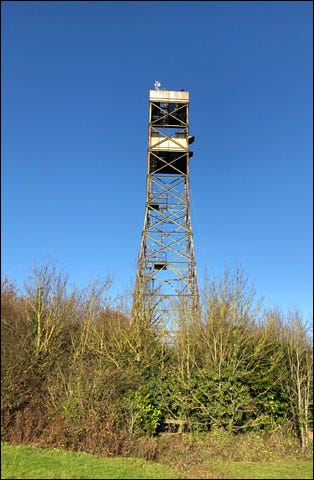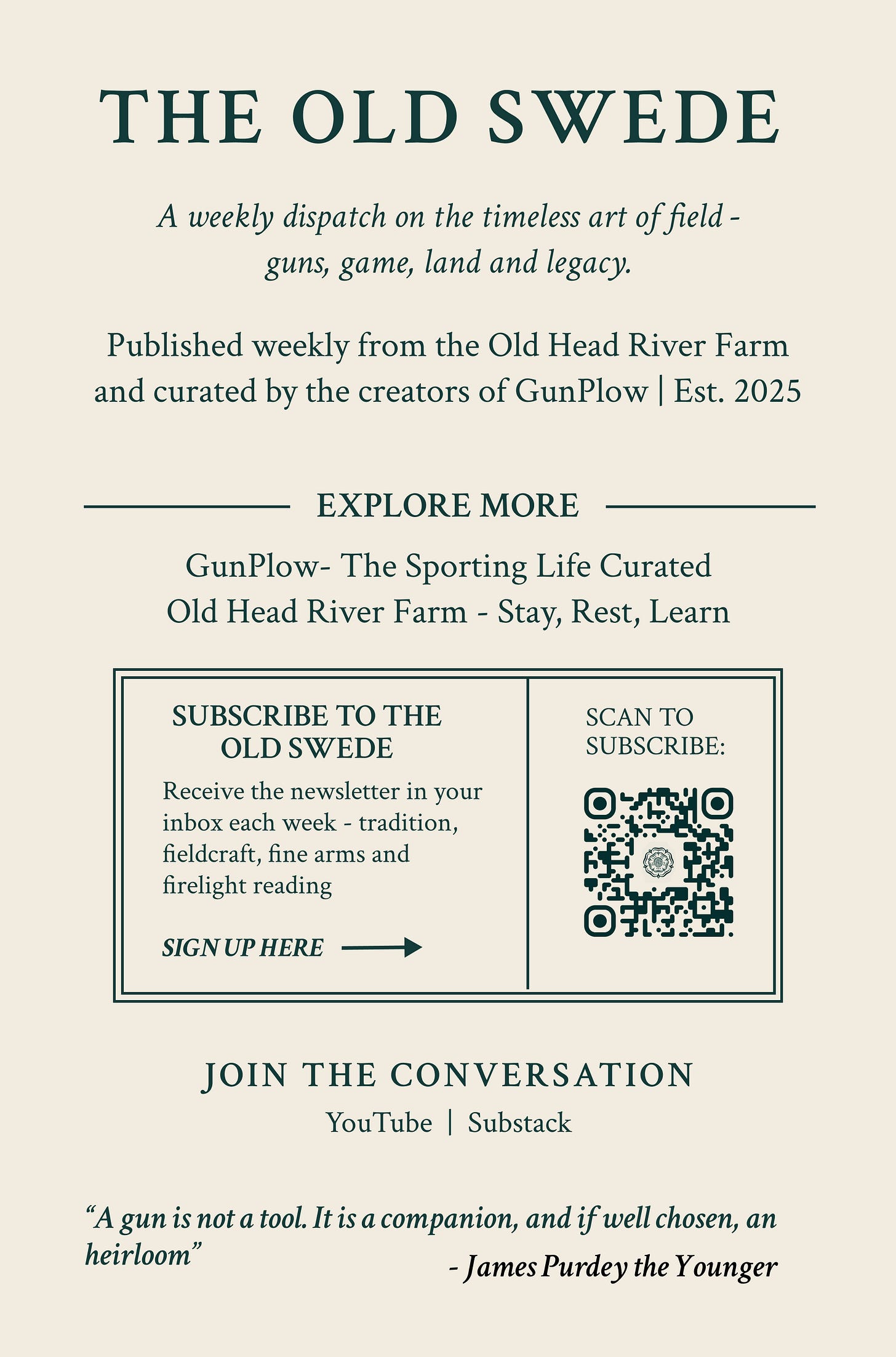The Old Swede: September 22, 2025
The Guns and The Ground: Barrels, butts, birds, and the table.
Featured Gunmaker
The Six Steps of Crafting a Bespoke Shotgun — Step 1: The Barrels
The first and arguably most critical stage in crafting a bespoke shotgun is the barrels. Companies like Purdey describe beginning this process with tubes machined to extremely tight tolerances—within four thousandths of an inch—before hand-filing to achieve perfect roundness and concentricity. (Purdey Guns & Rifles)
Once the raw barrel tubes are shaped, the maker profiles them using striking files to impart the desired silhouette and then silver-solders or tin-solders ribs and components in exactly conformant alignment. Chokes are cut individually and finished through lead lapping, which helps refine internal bore finish to tolerate minimal deviations—often less than half a thousandth of an inch. (Purdey Guns & Rifles)
Barrel alignment (on side-by-sides and over-unders) is then verified, ensuring the dumps, ribs, and muzzles align in visual sight and point-of-impact. The metal is struck up (for side-by-sides) or in the case of over-unders, assembled with demi-bloc or similar block joinery to increase stability. After this, the exterior finish and external profiling are refined.
This careful attention to barrel manufacture establishes the accuracy, handling, consistency, and even the aesthetic character of a bespoke shotgun. Without perfect barrels, the rest of the gun cannot deliver its promise.
Shooting School
The High Tower at West London Shooting School
The High Tower at West London Shooting School is a signature layout designed to simulate high pheasant drives with the challenge of speed and height. This tower supplements the school’s grounds of walk-ups and driven simulation, offering clays launched from significant elevation to test mount, lead, and follow-through.
In older days, tradition held that a young apprentice or stable boy—referred to affectionately as “a young buck”—would be tasked with climbing to the top of a tower or platform to release the clays by hand upon being “called for.” Chris Batha, a noted shooter and instructor, has recounted that one of his early jobs at WLSS involved just this: manually releasing birds from the tower as part of the clay routine.
What makes the High Tower educational is its demand for instant judgment of trajectory and speed: the higher elevation gives clay targets a simulated experience to that in the field, often in variable wind, forcing the shooter to anticipate lead and acceleration differently than from ground-level stands. For students preparing for driven game, particularly high pheasant, the tower develops consistency in eye-shot, rhythm, and confidence under aerial challenge.
Estate Visit
Ardtaraig, Argyll Scotland Shooting Estate
The Ardtaraig Shooting Syndicate, located at the head of Loch Striven in Argyll & Bute, Scotland, spans approximately 6,000 acres and is well-known for a challenging mix of driven pheasant and partridge.
Birds on the hillcrest fly fast and high, particularly those partridges driven around the hillside slopes where wind and terrain combine to test shot timing. Partridge drives are often round and “handsome,” demanding anticipation and composure from whoever stands the peg. (gunsonpegs.com)
The estate offers breathtaking vistas across glens and water, and the setting itself—pine-fringed ridges, wind-whipped moors—adds to the intensity of each drive. Accessibility is sufficient for parties willing to travel, but the remoteness contributes to quality: fewer interruptions, clearer line calls, and purer birds than more easily-reached lairs.
Guests often remark that the poultry style at Ardtaraig reminds them of grouse: tough birds, fast flight, unpredictable coverts. Though partridge, their presentation shares the same demands of instinctive shooting, clean breaks, and keen marking. The day ends not merely with tally card but with shared stories of near misses and sky-borne flashes of wings.
Fieldcraft Highlight
Percy Stanbury and His Shooting Methodology
Percy Stanbury (1894–1973) was chief instructor at the West London Shooting School, where he left a profound mark on British wingshooting technique. Known for his quiet authority and consistent results, Stanbury taught thousands of pupils, refining a pragmatic approach now recognized as the Stanbury Method.
At its heart, his style emphasized stance, balance, and rhythm. He advocated a stable foundation—feet shoulder-width apart, weight slightly forward—to allow fluid swing without over-reaching. His method prioritized keeping the gun low until the bird was committed, mounting smoothly into the shot rather than snatching at it (Shotgun Life).
Stanbury’s focus on economy of movement reduced wasted motion and improved consistency. He counseled shooters to let the bird set the tempo, matching its line and speed with a controlled swing. His emphasis on trigger control—a steady, unhurried pull—helped eliminate the flinching or jerking that so often spoiled otherwise good shots.
He also believed in the importance of gun fit and regularly worked with Webley & Scott, whose Model 700 became closely associated with him (The Field). The combination of a properly fitted gun and his disciplined technique made his method particularly effective for high, fast birds like driven pheasant or partridge.
What set Stanbury apart was not just his mechanics but his clarity: he taught a method any sportsman could learn, rooted in fundamentals rather than fashion. His legacy endures, with elements of his approach still forming the backbone of instruction at West London Shooting School today.
Shoot Lunch & Wine Pairing
Roast Partridge Recipes
Roast partridge is one of the pinnacles of the field luncheon; with game that is delicate yet full of character, it demands balanced seasoning and appropriate wine pairing.
A classic recipe: rinse and pat partridges dry, roast them in a hot oven (200 °C / 400 °F) for about 12-15 minutes, basting with melted butter and thyme. Rest for 5 minutes. Serve with roasted root vegetables—parsnips, carrots—and a jus made by deglazing the pan with a little red wine and game stock, finished with shallots and juniper berries.
For wine, consider a lightish red with lift and good undergrowth or herbal notes: a Pinot Noir from Burgundy or Oregon with soft tannins works beautifully; alternatively, a mature Barbera from Piedmont with cherry and earthy tones complements the game stock and root vegetables.
Another excellent pairing is an off-dry Riesling or Gewürztraminer if you prefer white: the residual sugar and acidity can cut through the richness while matching the herbal characteristics of the juniper.
Quote from the GunPlow Library
“In the field, every partridge is a little victory—not over the bird, but over imperfect light, wind that shifts mid-drive, memory that must recall where the last flush came from, and the gun that must follow. The bush-whisper of feathers, the soft report, and the measure between shot and silence—those are the moments a shooter lives for.”
— The Wild Game Cookbook by Mikael Einarsson & Hubbe Lemon
GunPlow Classic Library Coming Soon








